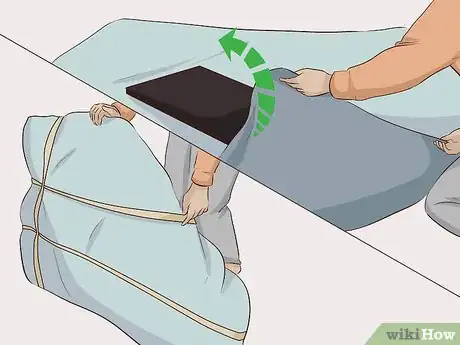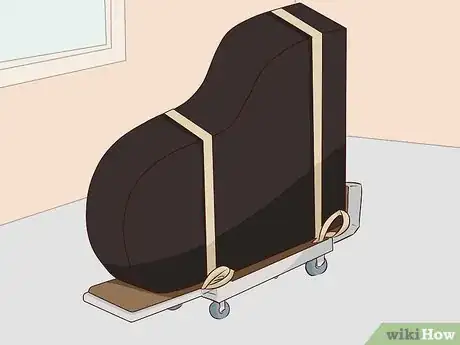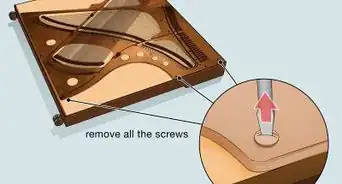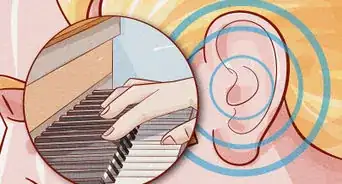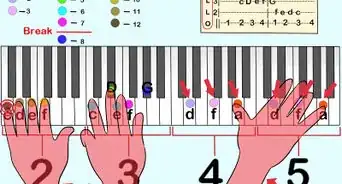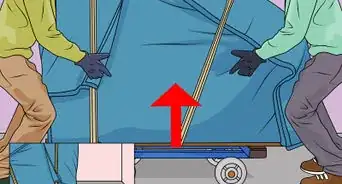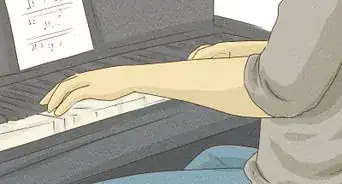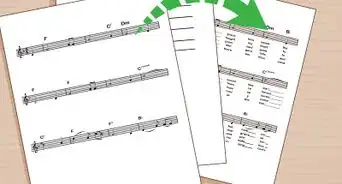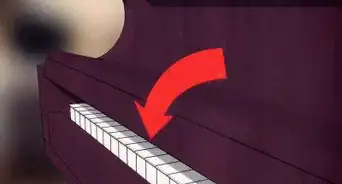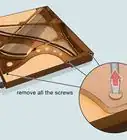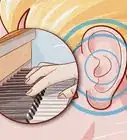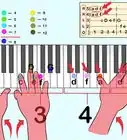This article was co-authored by Cindy Hofen. Cindy Hofen is a Certified Relocation Specialist and the founder of Managing Moves & More, a San Francisco Bay Area-based professional move management company specializing in start-to-finish moving solutions, home clearouts, estate sales, and home staging. Since 2009, her team has helped over 2,500 clients to simplify their transitions. Cindy has over 10 years of professional moving and organizing experience, is a member of the National Association of Senior Move Managers (NASMM), holds an A+ Accreditation, and belongs to the Diamond Society. She has a Master of Business Administration from Arizona State University and a BA in Business Economics from the University of California, Santa Barbara.
This article has been viewed 64,913 times.
Grand pianos are huge instruments, but they comprise many delicate and potentially breakable parts. You can move one over the course of an afternoon though. Ask a few friends to help you, since a grand piano is too heavy to move by yourself. Moving a grand piano begins with disassembling and safely packing all of the parts that can be removed from the body of the piano. Then, wrap every part safely in blankets or moving pads. Strap the wrapped piano firmly upright in the body of a moving truck, so that it won’t be damaged during the move.
Steps
Disassembling and Wrapping the Piano
-
1Remove the piano lid. The large lid of the grand piano will be attached by small screws and hinges on its longest side. Remove the screws and the hinges using the type and size of screwdriver that matches the screw heads. Lift the lid off of the piano, and set it aside.[1]
- You may need to hold the points of 3 or 4 different sizes of screwdriver against the screw to see which size fits properly.
- Save these screws—and all others that you remove while disassembling the piano—in a plastic bag for safekeeping. Place the lid hinges in the plastic bag, too.
- Label the bag “lid screws” so you can correctly re-assemble the piano lid.
-
2Wrap the lid in 2 or 3 moving pads. These pads will prevent the lid from being scratched or damaged during the move, so make sure the wood is fully covered by the pads. Then, use either packing tape or 2 buckle straps to hold the moving pads firmly in place.[2]
- You can buy thick moving pads at any moving-supply store, and at many hardware stores. If you don’t have the budget or inclination to use moving pads, you can also use spare blankets from around your house.
Advertisement -
3Remove the piano’s lyre. The lyre on a grand piano comprises the pieces of wood in the front of the piano (right beneath the keyboard) to which the pedals are attached. Kneel down and unscrew the lyre from the underside of the body of the piano. Set the lyre aside for now.[3]
- Keep all screws and any accompanying metal plates in a plastic bag.
- Label the bag “lyre screws” to prevent confusion between these and the screws for the lid hinges.
-
4Set the piano onto its side on a piano board. Place a piano board about 3 feet (0.91 m) to the left (when facing the keyboard) of the piano. Have another person (or 2) help you pick up the grand piano and tilt it towards its long, flat side. Set this side gently on top of the piano board. Never let the weight of the piano rest on the legs, as they can easily snap off.
- Do this very carefully, so as not to drop or damage any part of the piano. The movement should be controlled and guided at all times.
- A piano board is a large, flat wooden surface build to hold the side of a piano. Piano boards typically have handles to which you can strap the body of the piano. You can purchase a piano board at a local moving-supply store. They may also be available to purchase at larger music stores.
-
5Wrap the body of the piano with moving pads or blankets. Set 3 or 4 moving pads over and around the body of the grand piano. At this point, you don’t need to secure the moving pads directly to the piano, since the buckle straps you’ll use to hold the piano to the piano board will hold the moving pads in place, too.[4]
- It’s better to use too many pads than too few, to make sure the piano isn’t damaged during the move.
-
6Strap the piano to the piano board. Wrap at least 2 or 3 heavy-duty buckle straps around the body of the piano. Secure the straps to the handles or indentations of the piano board. The secured straps will keep the straps from shifting during the move and consequently keep the piano steady.
- You can purchase buckle straps at any hardware or home-supply store.
-
7Remove all of the piano legs. Most grand pianos have 4 legs, although some baby grands will only have 3. The legs will be attached to the bottom of the piano with screws or small bolts. Use either a screwdriver or an Allen wrench to remove the legs. Set them aside.
- Only remove the legs once the piano is firmly strapped onto the piano board.
-
8Wrap each pedal separately with plastic or bubble wrap. Once the lyre is off of the piano, you need to take precautions to keep the pedals from being damaged in the move. Wrap each with a section of protective plastic or, for added safety, a sheet of bubble wrap.
- Secure the wrap in place with packaging tape.
-
9Wrap the piano legs and lyre in blankets. Wrap each leg individually in its own blanket or moving pad, and wrap the lyre individual as well. Make sure that the wood of each is entirely covered up, and then secure the blanket in place using a generous amount of packing tape.[5]
- As with the piano lid, you want to keep the legs and lyre as safe as possible during the moving process.
Moving the Piano
-
1Set the wrapped body of the piano on a sturdy dolly. Have 2 or 3 people help you lift the wrapped piano on the piano board onto the dolly. The flat shelf of the dolly will be about 3 inches (7.6 cm) high, so you’ll need to lift the body of the piano at least that high. Make sure to center the piano on the dolly so that it won’t tilt off on one side or the other.
- A sturdy 4-wheeled dolly will be able to hold the weight of a large, heavy piano as it’s wheeled from stage to moving truck. Do not attempt to move a grand piano with a 2-wheeled dolly.
- You could offer your friends pizza and beer after the move is completed to entice them to help you.
-
2Roll the piano to a moving truck. Move slowly, and have 2 or 3 people help you roll the piano on the dolly. Keep the piano balanced and upright as you wheel it across sidewalks and the asphalt surface of the parking lot to the waiting moving truck.[6]
- If you need to move the piano down stairs, you could lay a piece of plywood on the stairs for the dolly to roll down.
- Remember to put safety first, and keep the piano from tipping over or rolling on someone’s foot.
-
3Strap the piano firmly in place. Wheel the piano and dolly up the loading ramp into the moving truck, and then lift the piano off of the dolly. (Or, if the dolly has wheel locks, keep the piano on the dolly and lock the wheels) Keep the piano in its vertical position. Then, use 3 or 4 buckle straps to secure the piano firmly to the wall of the moving truck.
- You’ll need to set the wrapped legs and lyre in the moving truck too, but these can be placed just about anywhere. You could even set them on the passenger seat in the cab with you.
- It’s best to rent a moving truck when moving a piano. Even if the piano would fit in a large pickup truck bed, you won’t be able to strap the piano vertically to the side of the truck.
-
4Hire a piano moving company. If you don’t have time to properly disassemble, pack, and move the piano, you can contact a piano-moving company and have them do it for you. These companies are highly specialized and move only pianos, so they’re skilled at what they do. Look for a piano-moving company on the Piano Movers Network directory: https://www.pianomoversnetwork.com.
- Piano moving companies will also have insurance in case they damage your piano. This means that, should the piano accidentally be dropped, the company will pay for the damage. It won’t come out of your pocket.
- A local move will likely cost between $150 and $600 USD, depending on the size of the piano and the complexity of the move.
- A long-distance move will average between $700 and $2,000 USD, depending on the distance moved.
- Read reviews and get quotes from a few different companies before you settle on one.[7]
Community Q&A
-
QuestionHow do I lock a grand piano's soundboard?
 Community AnswerThere should be a knob on the front that you twist. It'll be just on the right as you sit at the piano.
Community AnswerThere should be a knob on the front that you twist. It'll be just on the right as you sit at the piano. -
QuestionDo I need to remove the keyboard to transport a baby grand piano?
 Kim GTop AnswererNo. You can protect the keyboard by putting the keyboard lid down and locking and securing it into place. Removing the keyboard can cause damage to the piano, and it should only be done when it would be otherwise impossible to move the piano.
Kim GTop AnswererNo. You can protect the keyboard by putting the keyboard lid down and locking and securing it into place. Removing the keyboard can cause damage to the piano, and it should only be done when it would be otherwise impossible to move the piano.
Things You’ll Need
- Screwdriver
- Allen wrench
- Plastic bags
- Moving pads or blankets
- Plastic wrap or bubble wrap
- Packing tape
- Buckle straps
References
- ↑ https://homesteady.com/how-4760287-move-grand-piano.html
- ↑ https://homesteady.com/how-4760287-move-grand-piano.html
- ↑ https://homesteady.com/how-4760287-move-grand-piano.html
- ↑ https://www.youtube.com/watch?v=b9UOD8g12aA&feature=youtu.be&t=56s
- ↑ https://homesteady.com/how-4760287-move-grand-piano.html
- ↑ https://www.youtube.com/watch?v=b9UOD8g12aA&feature=youtu.be&t=1m34s
- ↑ Cindy Hofen. Certified Relocation Specialist. Expert Interview. 13 February 2020.
About This Article
If you need to move a grand piano, make sure you carve out a few hours and find a few friends to help. The first thing you'll need to do is remove your piano's lid and lyre and wrap them up in moving pads or blankets. Then, set your piano on its side on a piano board and wrap up the body. Strap the piano to the piano board with buckle straps, then remove all of the legs and wrap them up. Wrap each pedal individually with bubble wrap. Once your piano is wrapped up and secure, you can put the piano board on a dolly and transport it to a moving truck. To learn how to hire a piano moving company, keep reading!

